- AI Fire
- Posts
- 💥 n8n Just Launched An AI That Builds Your AI Automations FOR YOU
💥 n8n Just Launched An AI That Builds Your AI Automations FOR YOU
This is not a drill. The new "AI Workflow Builder" lets you build complex automations with simple text prompts. It's like Cursor, but for n8n
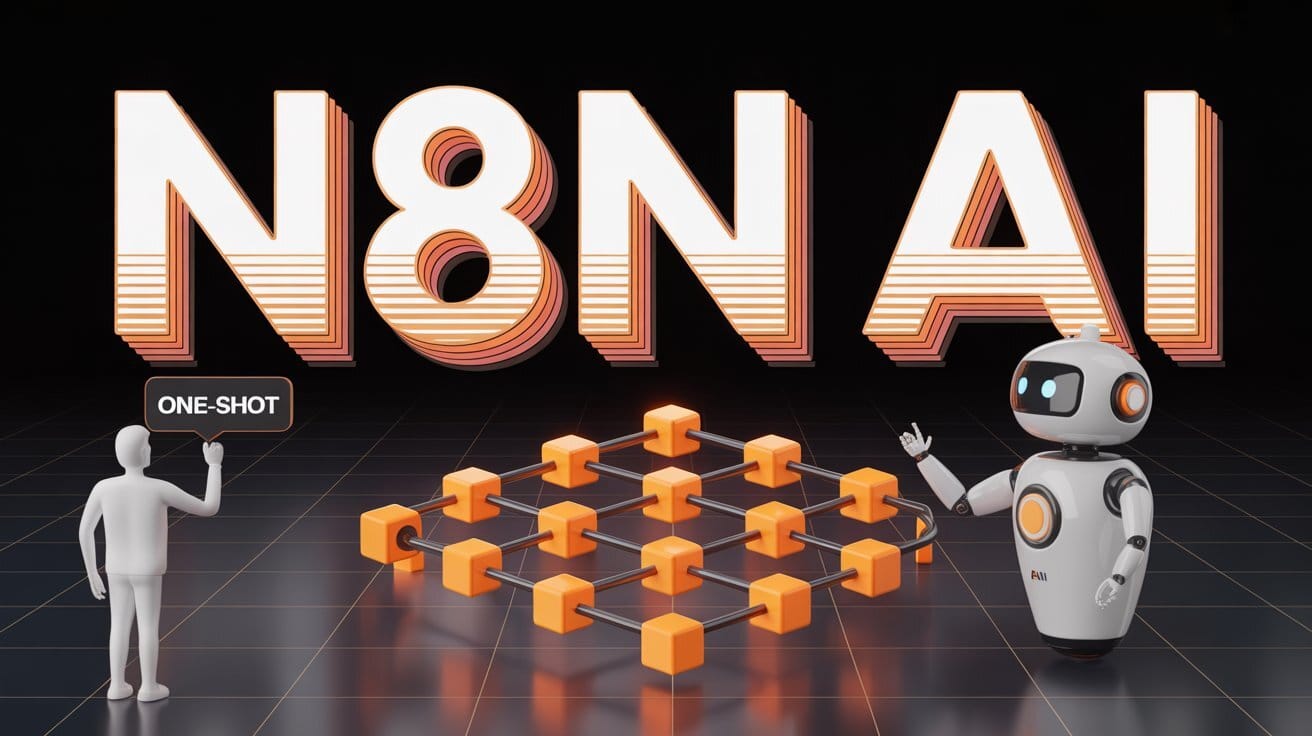
🤖 What's the BIGGEST Pain Point When Building an n8n Workflow?This guide is about n8n's new AI Builder, which automates the building process. What's the most frustrating part of the traditional, manual way of building? |
Table of Contents
Introduction: The Game-Changing Update
Building AI agents just got 10 times easier. What used to take 10-30 minutes for an expert - or hours for a beginner - now takes just two minutes. This is all thanks to n8n's amazing new AI Workflow Builder.
This isn’t a small upgrade; it’s a complete change in how we build automations.
We will build three increasingly complex agents to demonstrate their power, their limitations and the new strategies you must adopt to stay competitive.
The examples you see today are the worst they’ll ever be, as these AI models and tools will only continue to improve. The barrier to entry for building powerful AI solutions has just been destroyed and this guide shows you how to take advantage of it.
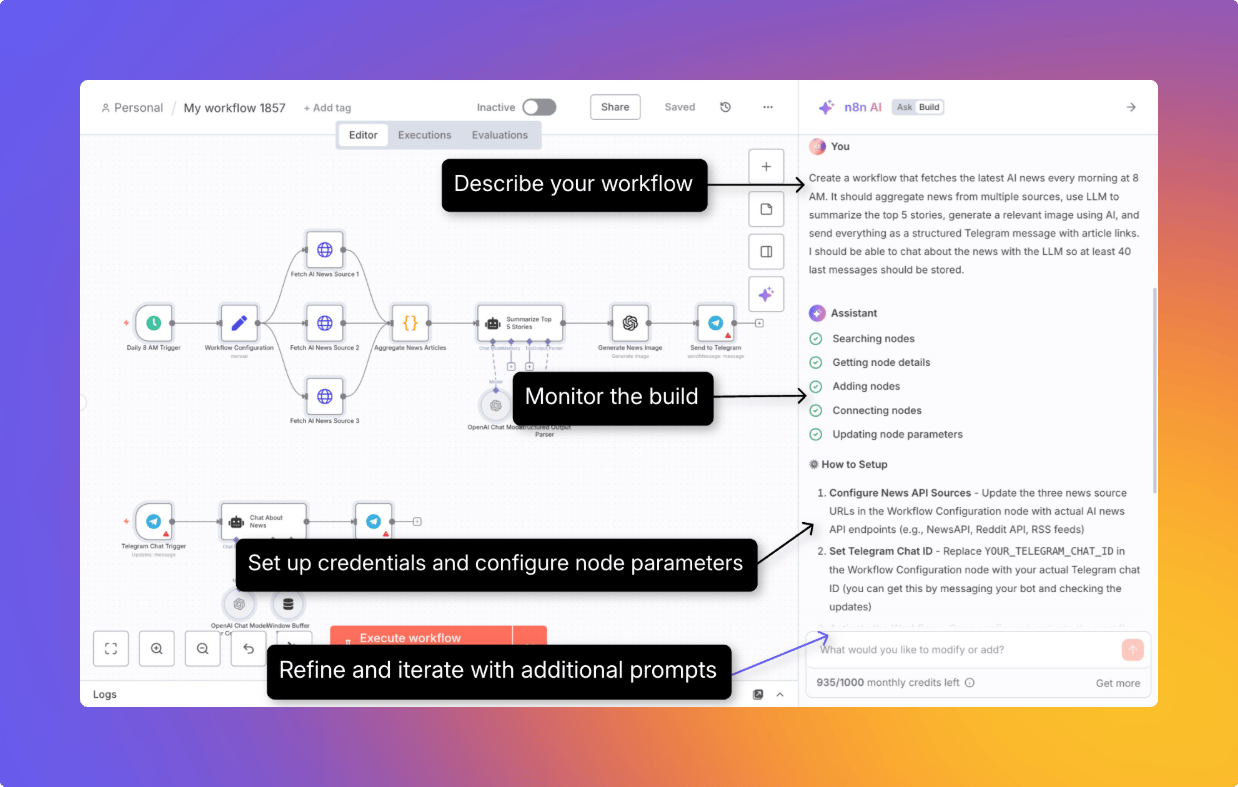
Why This Changes Everything
The leap in efficiency is hard to exaggerate. It represents a basic shift in the time, cost and skills required to build powerful automations.
The Old Reality: A Game for Experts
Previously, building even a "simple" AI automation was a significant undertaking.
Time Investment: A basic automation could take 10-15 minutes for a seasoned n8n user. For a beginner navigating the interface for the first time, a 30+ minute build was common. Complex, multi-step workflows could easily consume several hours.
The Challenges: The learning curve was steep. You had to:
Manually research and select the correct nodes from hundreds of options.
Understand and navigate the complex, often frustrating, credential setup process (especially for tools like the Google API).
Manually connect all nodes and configure every parameter.
Spend significant time debugging errors in variable mapping or node configurations.
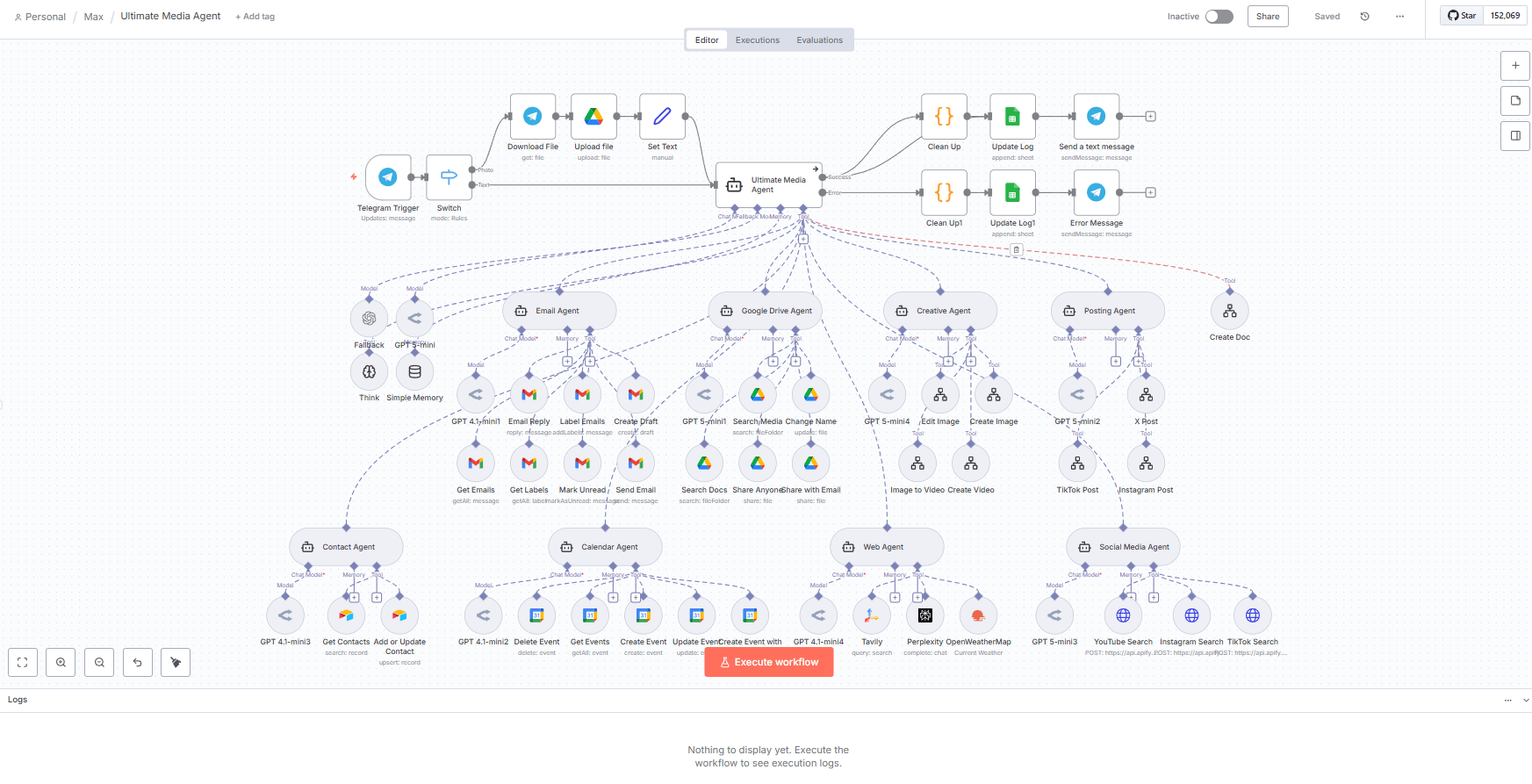
The New Reality with n8n AI: Your AI Co-Pilot
The new AI Workflow Builder acts as an expert co-pilot, handling the boring work for you.
Time Investment: A simple automation can be built in 1-2 minutes. A complex workflow can be structured in 5-10 minutes. A "one-shot" build can be completed in 30-90 seconds.
The Simplified Process:
Natural Language: You describe what you want in plain English.
Automatic Node Selection: The AI chooses the correct tools for the job from its documentation.
Auto-Filled Credentials: It intelligently selects your pre-saved credentials (e.g., "Gmail" or "Google Calendar").
Auto-Connected Workflows: It automatically connects the nodes in the correct logical sequence.
Pre-Configured Parameters: It even fills in the necessary parameters and settings within each node.
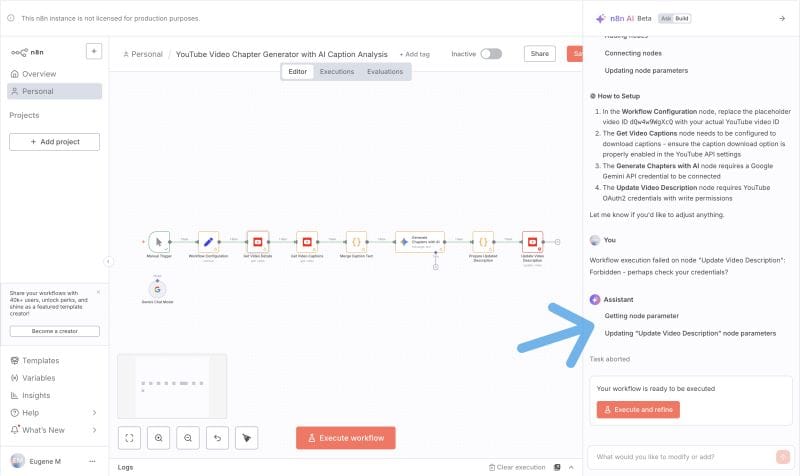
Understanding the n8n AI Workflow Builder
This new feature is more than just a chatbot. It's an active agent with access to the entire n8n platform, capable of both advising and building.
Accessing the Feature
You can access the AI Workflow Builder in two ways:
Click the prominent "Build with AI" button on a blank canvas.
Click the "n8n AI" button in the main toolbar at any time.
A Quick Note: This feature is being rolled out slowly. If you don't see it in your n8n instance yet, it should arrive within a few days of this guide's publication.

The Revolutionary Concept: AI Building AI
This is the core of the revolution: you are now using AI to build AI agents and automations. The workflow builder is not a simple helper; it's a deeply integrated system.
It has complete access to all n8n documentation.
It has knowledge of all 500+ nodes and connectors.
It understands best practices for workflow structure.
It can configure parameters automatically based on your request.
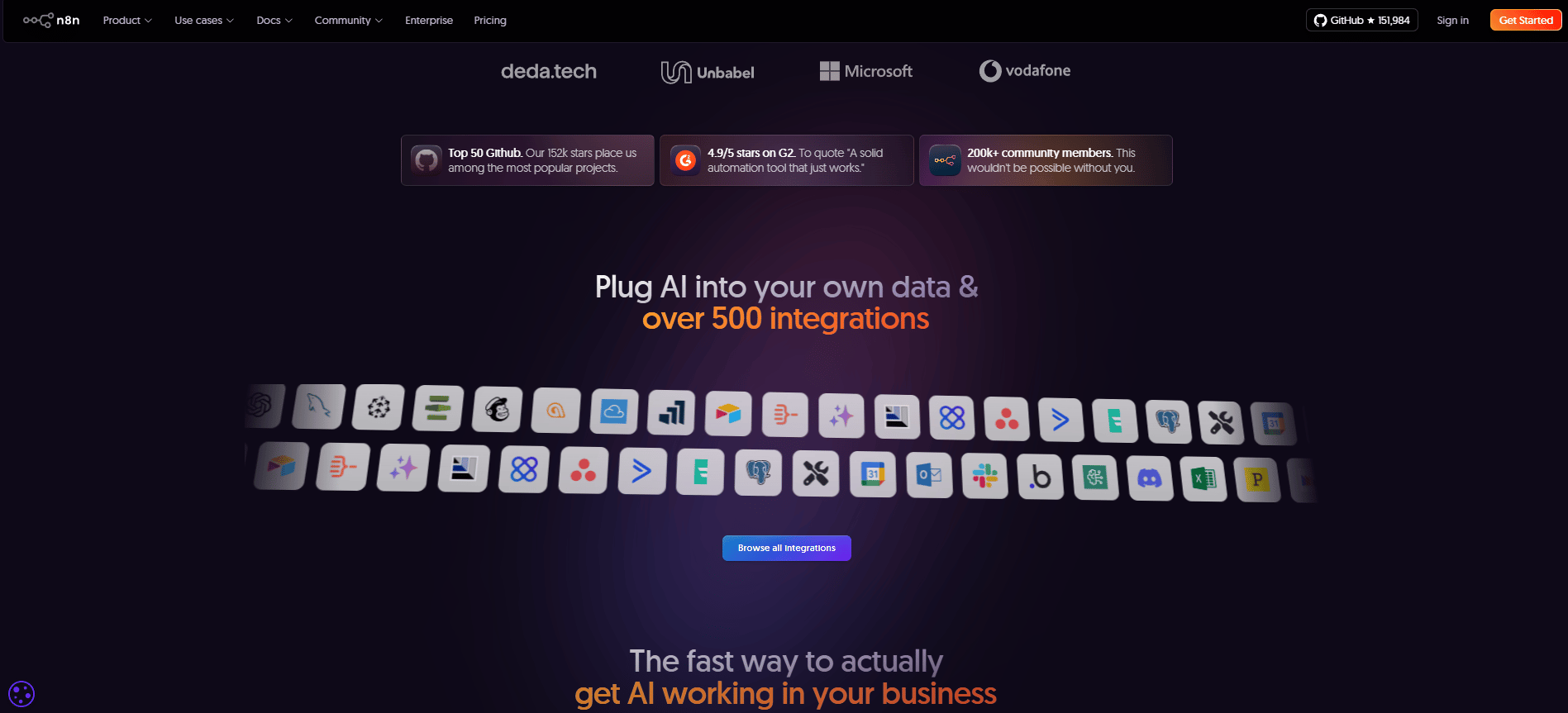
The Two Modes: "Ask" vs. "Build"
The AI Builder operates in two distinct modes and knowing the difference is critical.
Ask Mode (Your Consultant):
Function: This mode is for advice and, most importantly, doesn't change anything.
What it does: It explains documentation, suggests different approaches to a problem and answers questions about your workflows.
What it doesn't do: It will not make any changes to your automation.
Use When: You want to understand why something isn't working or explore options without modifying your existing work. It’s your co-pilot for strategy.
Build Mode (Your Builder):
Function: This is the active, powerful agent that makes changes to your canvas.
What it does: It actively adds nodes, connects workflows, configures parameters and updates credentials based on your prompts.
Use When: You are ready to create a new workflow or modify an existing one. This is your co-pilot for execution. "With great power comes great responsibility", so always double-check its work.

The 1,000 Character Limitation
There is one current limit that power users will hit immediately.
The Limit: Build mode currently limits prompts to 1,000 characters.
Why This Matters: Many complex, real-world automation descriptions are much longer than 1,000 characters.
The Workaround: As shown later, the best approach is to use external AI tools (like Claude Sonnet 4.5) to break down your complex build into a series of smaller, manageable, node-by-node prompts that fit within the limit.
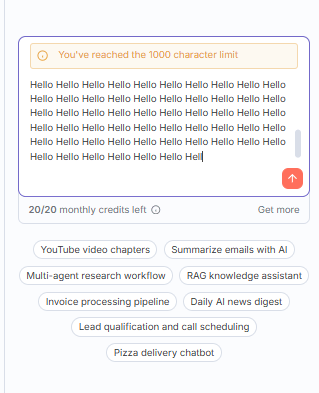
Agent 1: Simple Email Response Automation
Let's put the builder to the test with a simple, common workflow.
The Build Challenge
Objective: Create an automation that monitors a Gmail inbox, generates an AI-powered response to incoming emails and creates a draft reply automatically.
Historical Context: This workflow would have previously taken 10-15 minutes for an expert and over 30 minutes for a beginner.
The Build Process
Step 1: The Simple Prompt
A single, natural language prompt is given to the AI Workflow Builder:
I need you to create an AI Agent workflow with the purpose of drafting replies to any unread emails in my inbox.Step 2: Watch n8n AI Work
The AI performs all the following steps automatically in about 30-40 seconds:
Searches available nodes: It accesses its complete n8n documentation.
Adds necessary nodes: It correctly selects the
Gmail Trigger,AI AgentandGmail(send) nodes.Connects nodes: It orders and links them in the correct logical sequence.
Updates parameters: It fills in the basic configurations for each node.
Adds credentials: It intelligently pre-fills the credential slots with the user's connected accounts.
What the AI Built: The resulting workflow structure is perfect:
Gmail Trigger(to monitor the inbox).AI Agentnode (to generate the response).Gmailnode (to create the draft).
Impressive Details:
The AI Agent node was automatically configured with a system prompt based on the request.
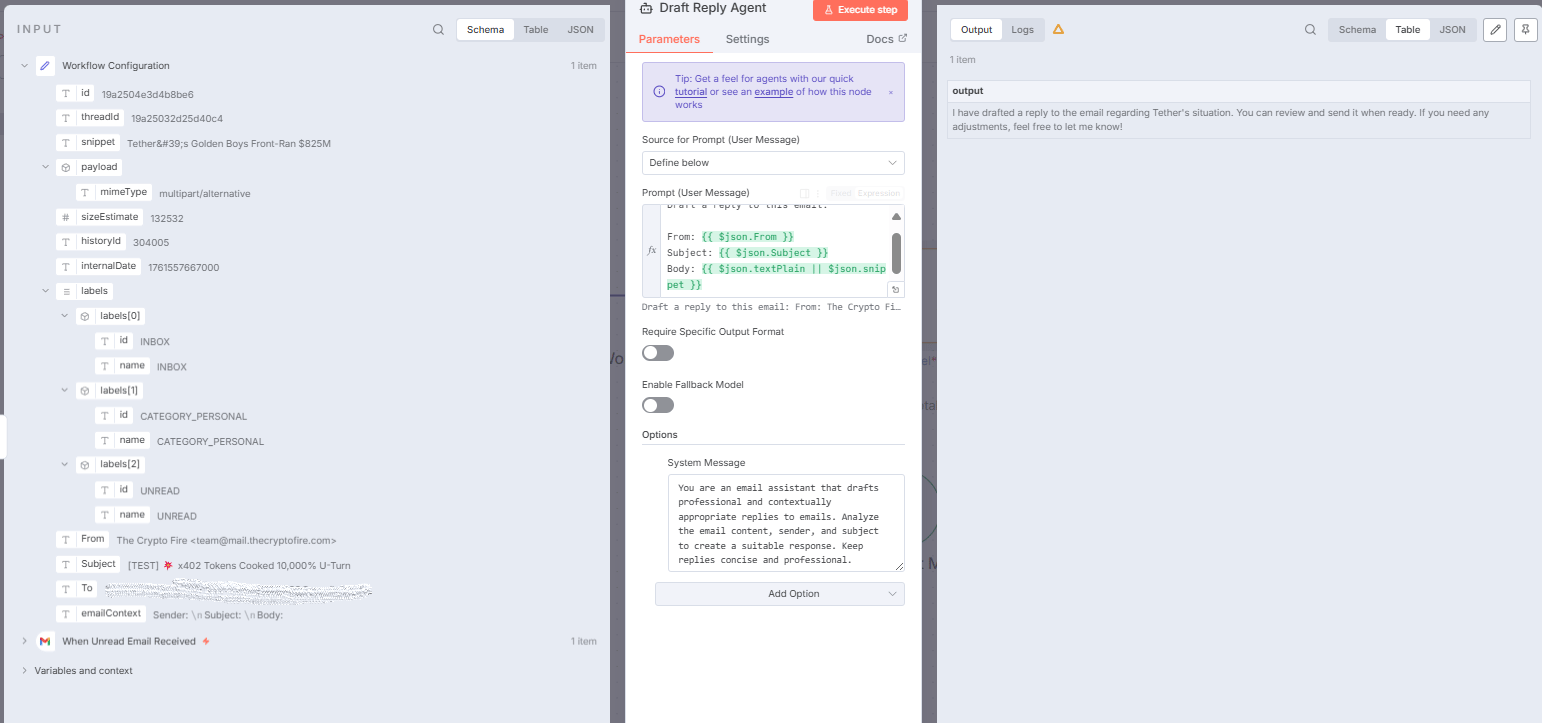
A model was selected (GPT-4o mini).
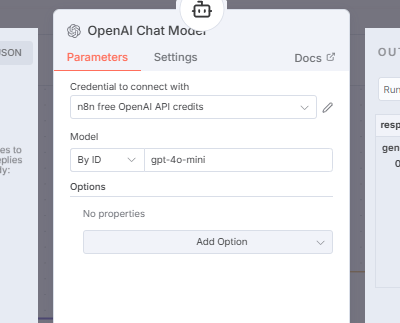
The Gmail credentials were pre-filled and ready to go.
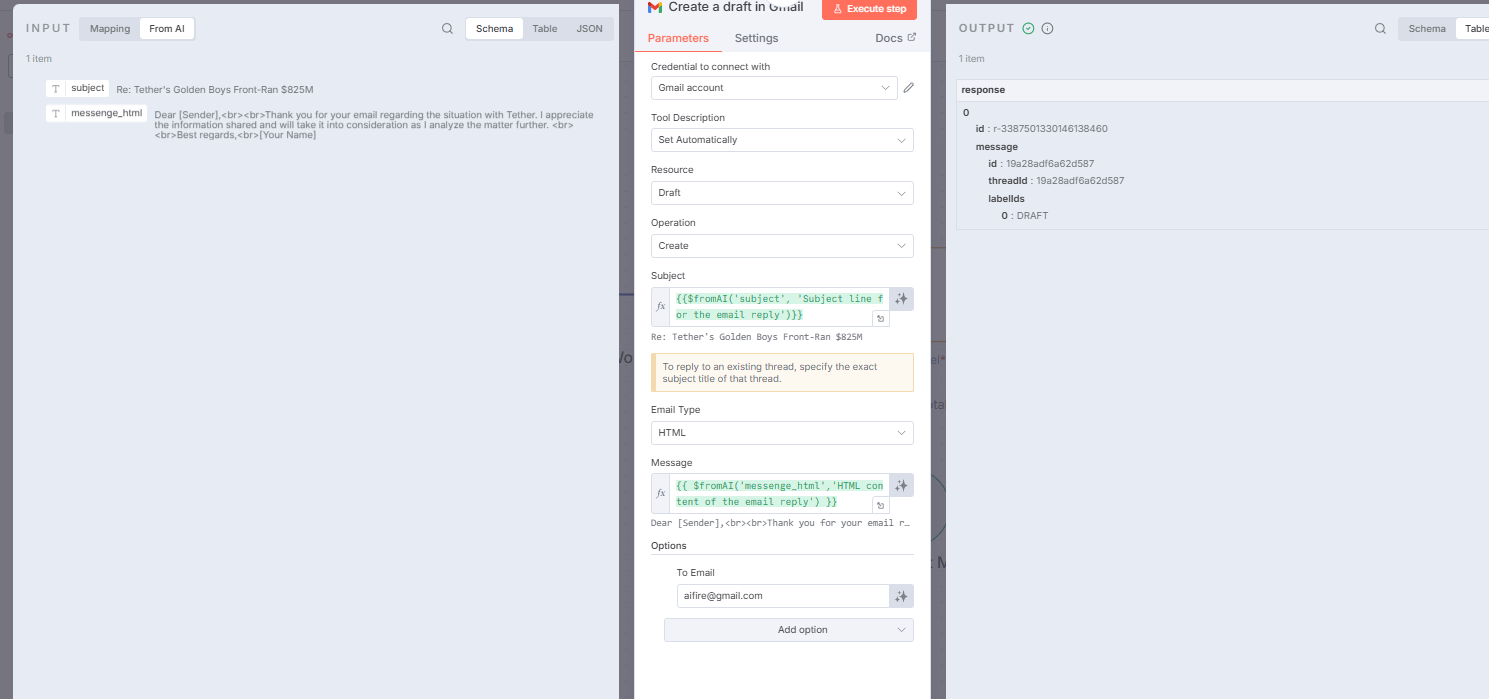
All essential parameters were set appropriately.
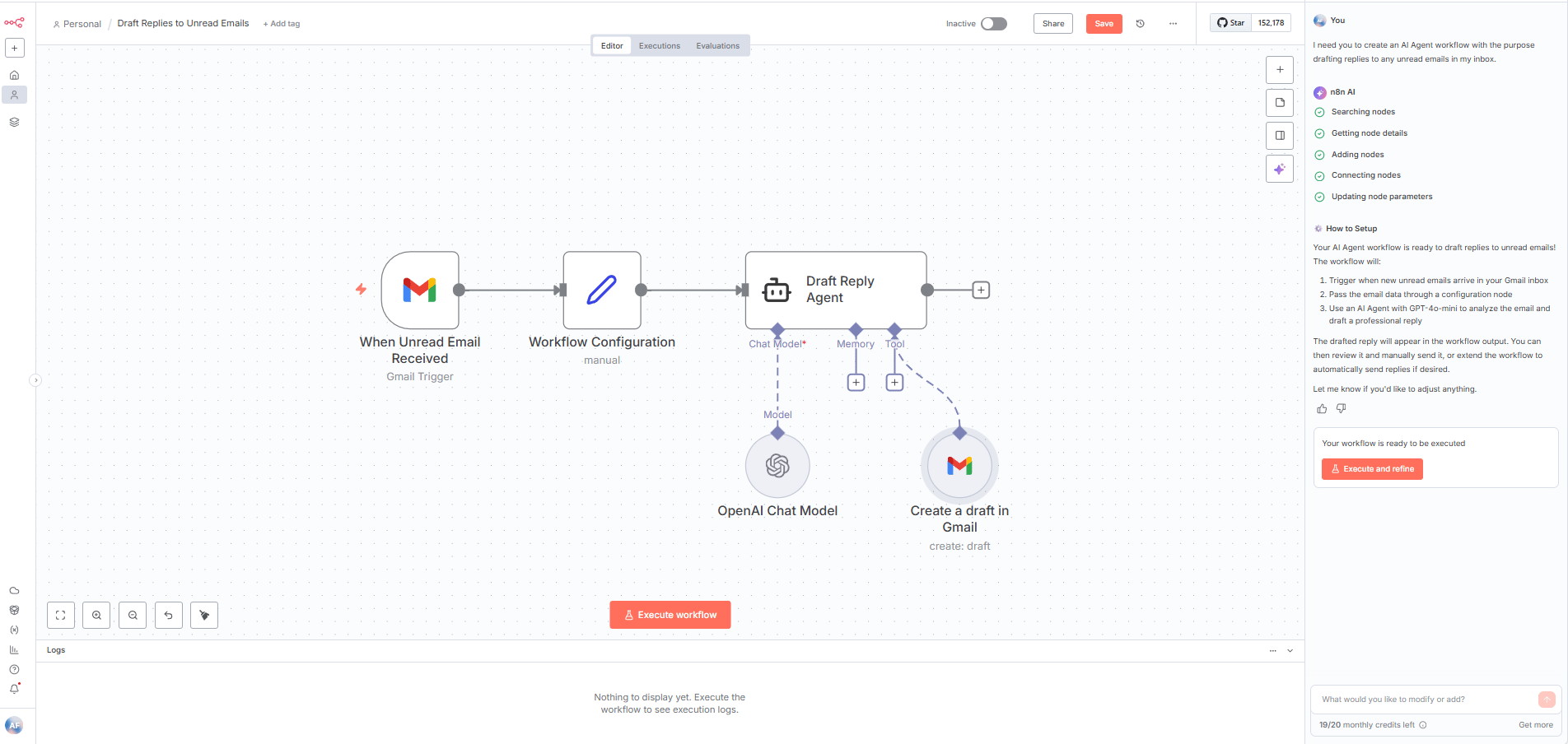
Testing and Refinement
First Test: Clicking "Execute and Refine" showed no initial errors and a draft was created successfully.
Minor Issue: The content of the draft was empty. A quick diagnosis showed the AI had mapped the wrong variable in the "Content" field.
The Fix: The incorrect variables were deleted and the correct snippet was dragged in from the previous node.
Second Test: A minor error occurred in the Gmail tool where the AI tried to generate a placeholder email address.
The Fix: The sender email address was manually mapped.
Third Test: Success! A perfect draft was created with relevant, clear, AI-generated content.
Total time including fixes: ~3 minutes.
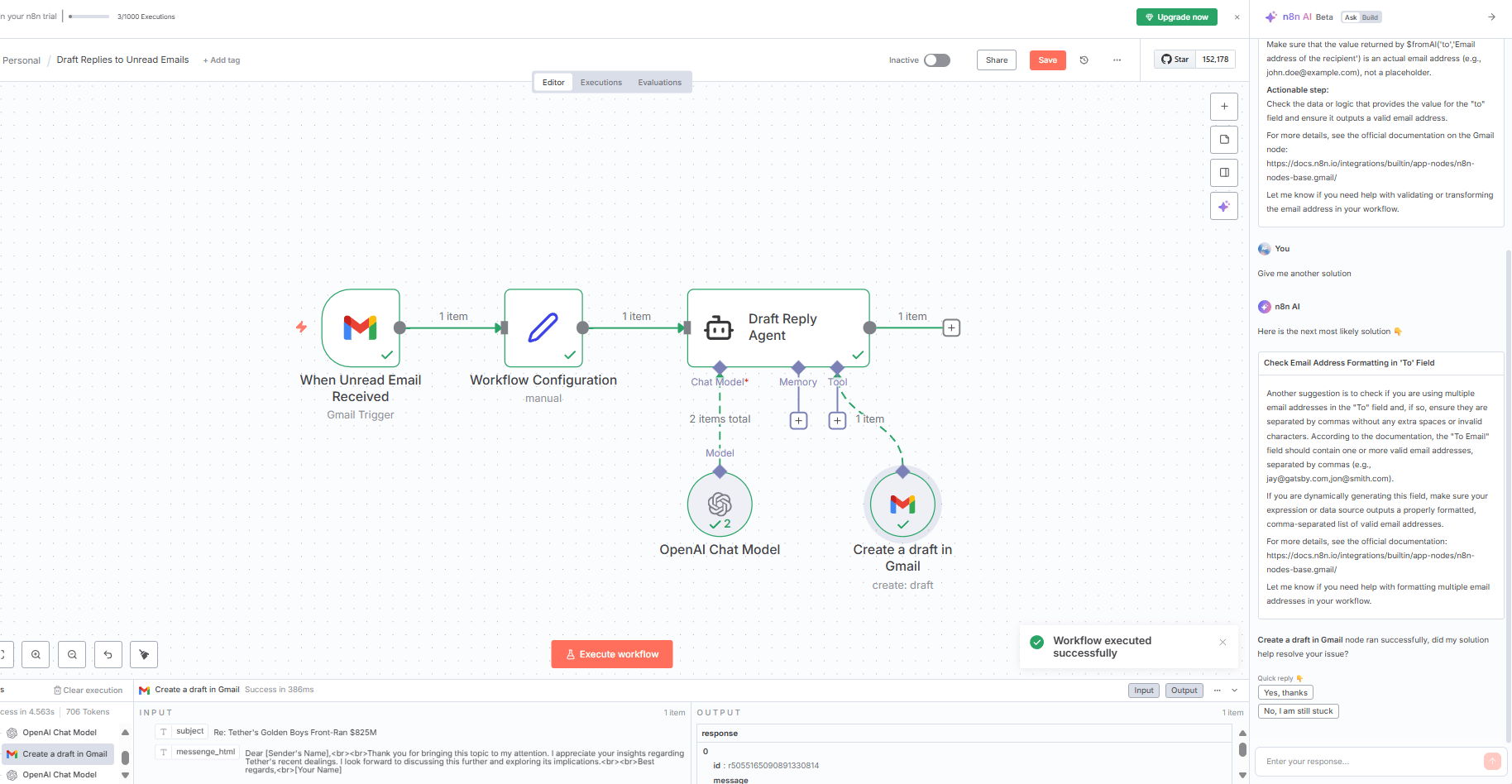
Key Takeaway
The verdict is clear: What would have taken 10-30 minutes and involved significant manual configuration now takes 1-3 minutes, even with minor, easily fixed problems. This is a massive leap in productivity.

Enhanced Features in the Update
This AI builder wasn't the only improvement. n8n also rolled out key updates that remove major problems for all users, especially beginners.
Simplified Google Authentication
This is a huge quality-of-life improvement.
The Old Way: A nightmare of navigating the Google Cloud Console, creating OAuth credentials, configuring client IDs and secrets and setting up redirect URLs. It was a complex, multi-step process that was the #1 barrier for new users.
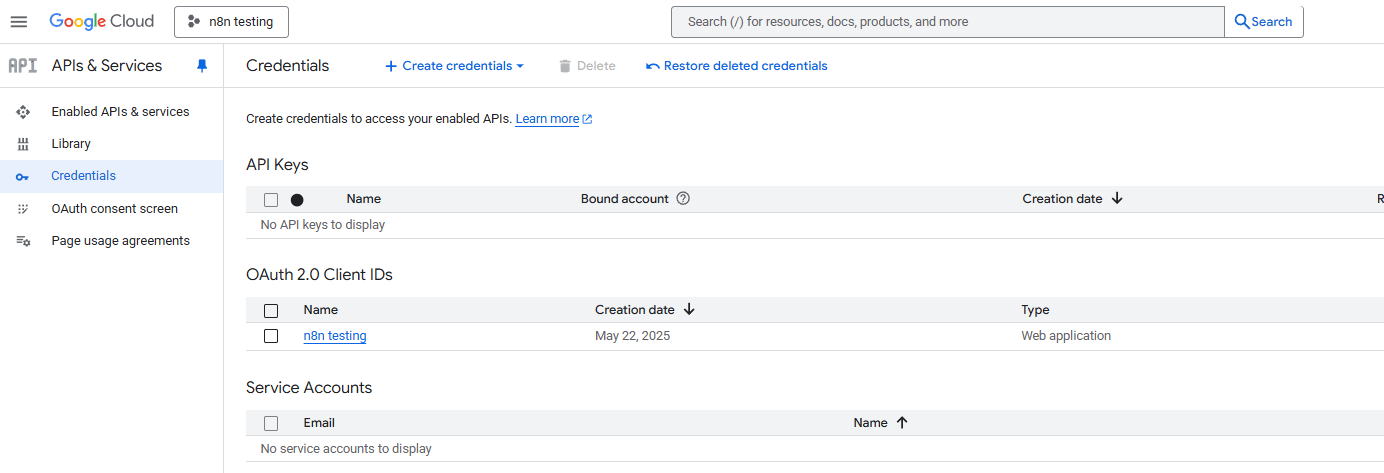
The New Way:
Click "Create new credential".
Click "Sign in with Google".
Select your account and grant permissions.
Done. The connection is successful.
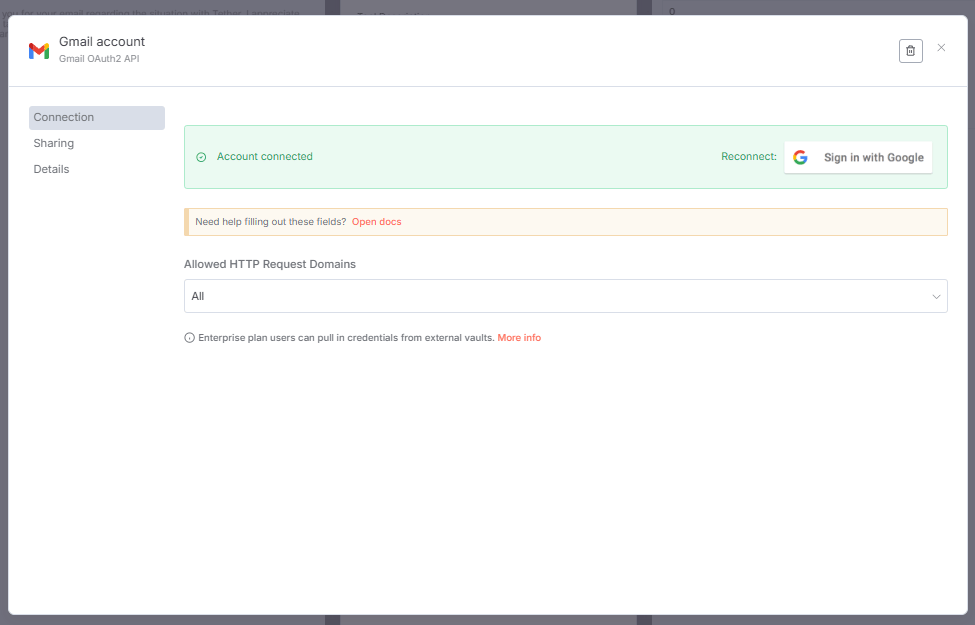
Why This Matters: n8n went through a costly and time-consuming Google audit to enable this one-click process, demonstrating their commitment to user experience and accessibility. This removes the single biggest challenge for beginners.
Improved Credentials Management
The platform is now smarter about how it handles your connected accounts. Credentials are auto-selected when appropriate, the AI provides context-aware suggestions for which credentials to use and error messages are clearer when an authentication fails.
Agent 2: Advanced Calendar Analysis with Multi-Step Build
Now, let's test the AI Builder with a more advanced, multi-step workflow that requires logic, data transformation and reporting.
The Challenge
Objective: Build an agent that triggers daily at 6 PM, analyzes all of today's calendar events, calculates productivity metrics (like total meeting time), generates a professional HTML report and emails that summary.
Complexity: Medium-Advanced.
Historical Build Time: 30-60 minutes for an expert.

The 1,000 Character Workaround in Action
The Problem: A detailed description of this entire 6-node workflow easily exceeds the 1,000-character prompt limit.
The Solution: Use an external AI (like Claude Sonnet 4.5) to create a step-by-step instruction plan. Then, build the workflow one node at a time.
The AI-Assisted Approach
Describe the complete automation goal in Claude (which has no small character limit).
For example, here is my description:
Build an n8n workflow:
* Trigger: every day 18:00.
* Vars: RECIPIENT_EMAIL, TIMEZONE.
* Calendar: fetch today's events from the specified Google Calendar using TIMEZONE.
* Normalize each event (summary, description, start, end, duration, attendee_count, html_link, location, status organizer, all_day). Output a JSON array.
* AI step (e.g., GPT-4) with system rule: ONLY use provided events; no fabrication. Categorize events, compute metrics and return HTML.
* Report must include:
Executive summary with real titles/times.
Metrics table: hours by category, focus ratio, context switches, key calculations.
Problematic meetings + actionable fixes.
Wins/shipped items from titles/descriptions.
Tomorrow plan: focus blocks + quick wins.
* Email: send via Gmail to RECIPIENT_EMAIL with subject "Daily Calendar Analytics & Productivity Report - [YYYY-MM-DD]" and the AI HTML as body.
//
I want to build this workflow 1 node at a time, using n8n's new ai workflow builder (browse the web). Send me a prompt for each node we need. I'll attach screenshots for the overview workflow I haveGet Instructions: Claude provides detailed step-by-step instructions, explaining each node individually.
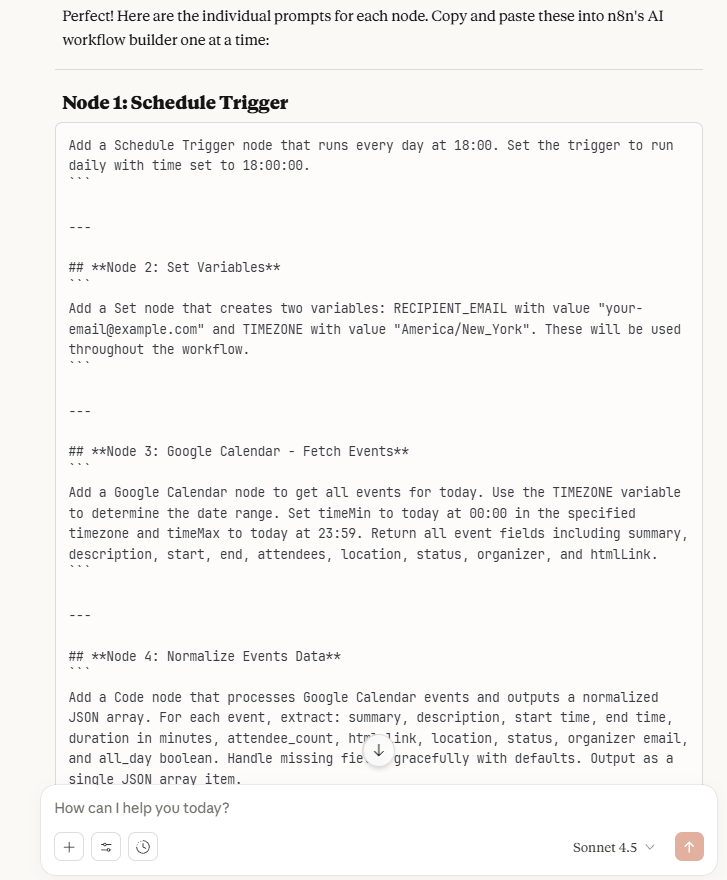
Build Node-by-Node in n8n:
Copy the prompt for the first node from Claude (e.g., "Create a daily trigger at 6 PM").
Paste it into n8n AI Build Mode. Let it build that node.
Copy the prompt for the second node ("Add set node…").
Paste it. The AI will add and automatically connect it.
Repeat this process for all nodes.
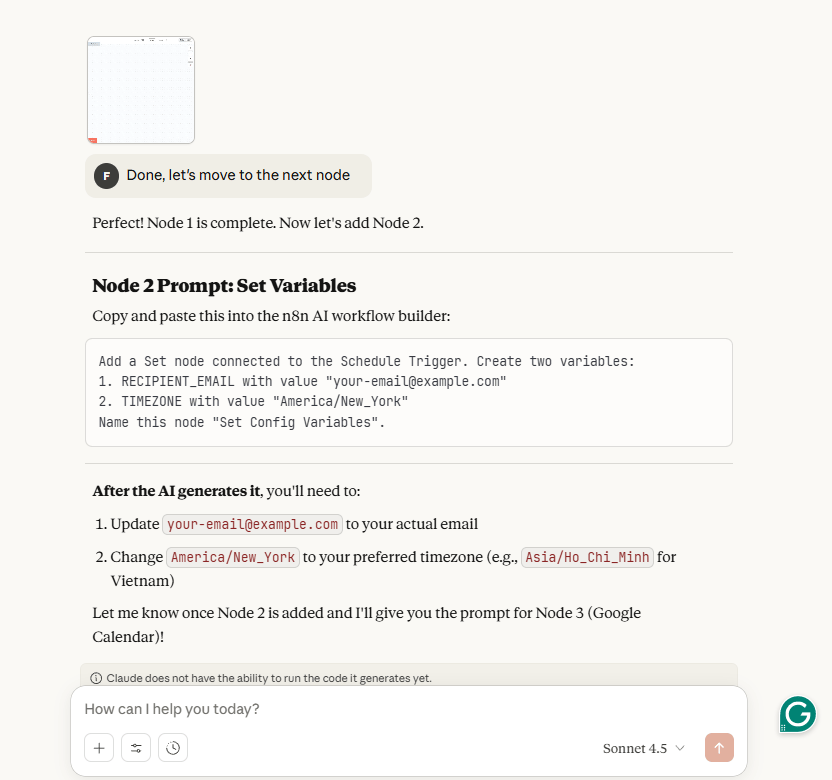
Why This Node-by-Node Approach is Better
Focused Building: The n8n AI can concentrate on one component at a time, resulting in higher accuracy for each step.
Avoids "Debugging Hell": This method prevents the AI from making a massive, 25-node error that takes longer to fix than building it manually. Issues are isolated to single components.
Human-in-the-Loop Quality Control: You review and verify each node's configuration before proceeding to the next, catching errors early.
Node-by-Node Build Process Highlights
Node 1: Daily Trigger
"Create a daily trigger at 6 PM". Build Time: ~10 seconds. Result: Perfect.
Node 2: Set Variables:
"Add a Set node with start_date and end_date variables for today". Result: Perfect, auto-connected.
Node 3: Get Calendar Events
"Add Google Calendar node to get today's events". Result: Perfect and it used the new, simplified Google OAuth flow.
Node 4: Transform Events (Code Node)
This is a key step. The AI code generated by Claude Sonnet 4.5 was used instead of n8n AI's code, as Sonnet 4.5 specializes in high-quality code generation. The result was cleaner, more efficient code.
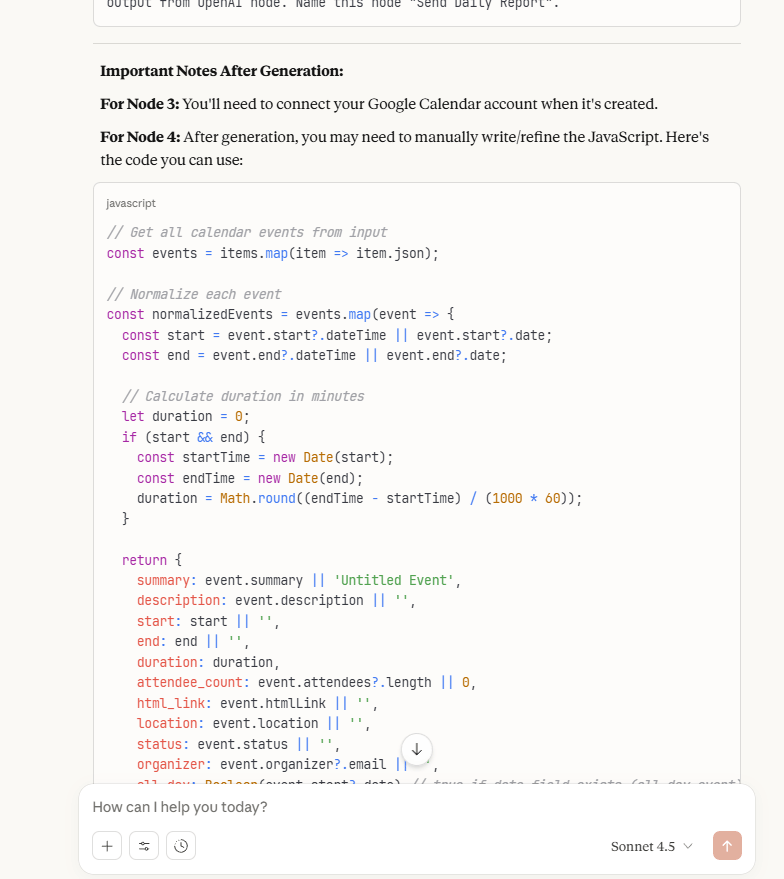
Node 5: AI Analysis Agent
The AI correctly generated a comprehensive system prompt and user prompt and even added XML tags (<events>..._</events>) for better context structure - a professional prompt engineering technique.
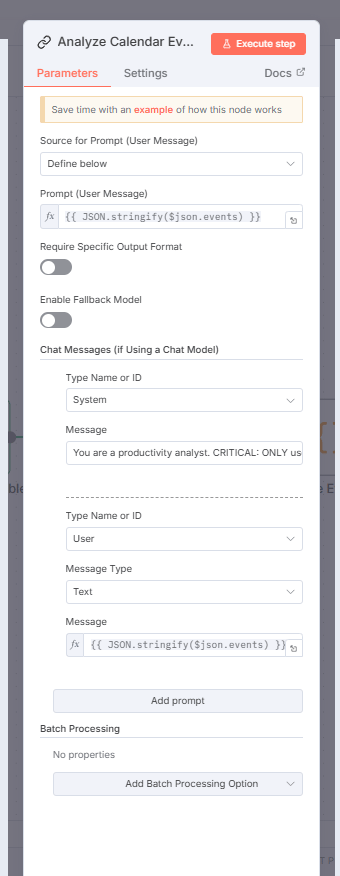
Node 6: Send Email Report
The Gmail node was added, credentials auto-connected and all fields (subject, body, HTML format) were configured.
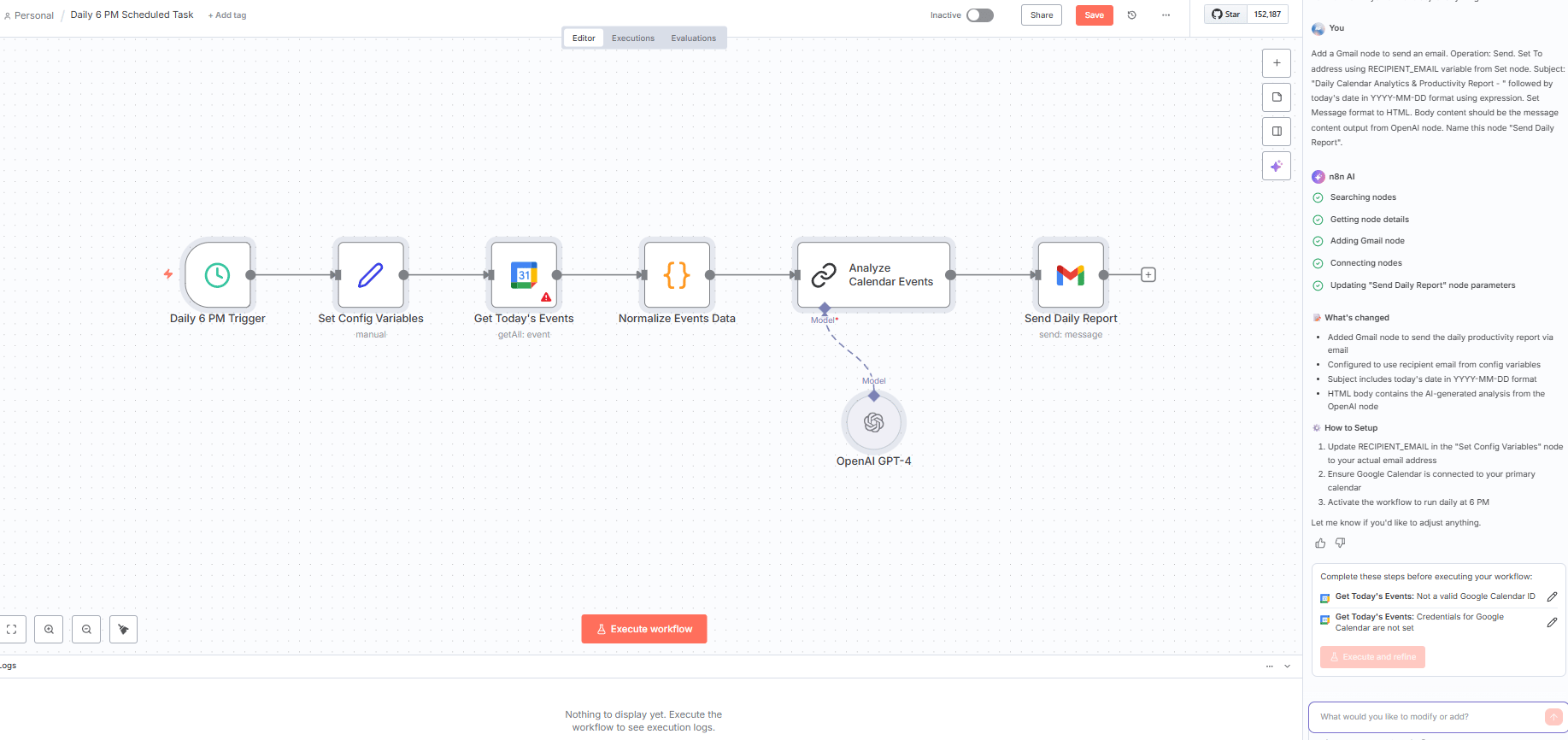
Testing and Results
First Full Run: All nodes executed and the email was received... but the report was empty.
Diagnosis: A classic coding error. The Code node was outputting
[object Object]instead of the actual data.The Fix: The code was modified with
JSON.stringifyto correctly format the data.Second Run: Success! A comprehensive HTML report was generated and emailed, including total events, average duration and a full event-by-event analysis.
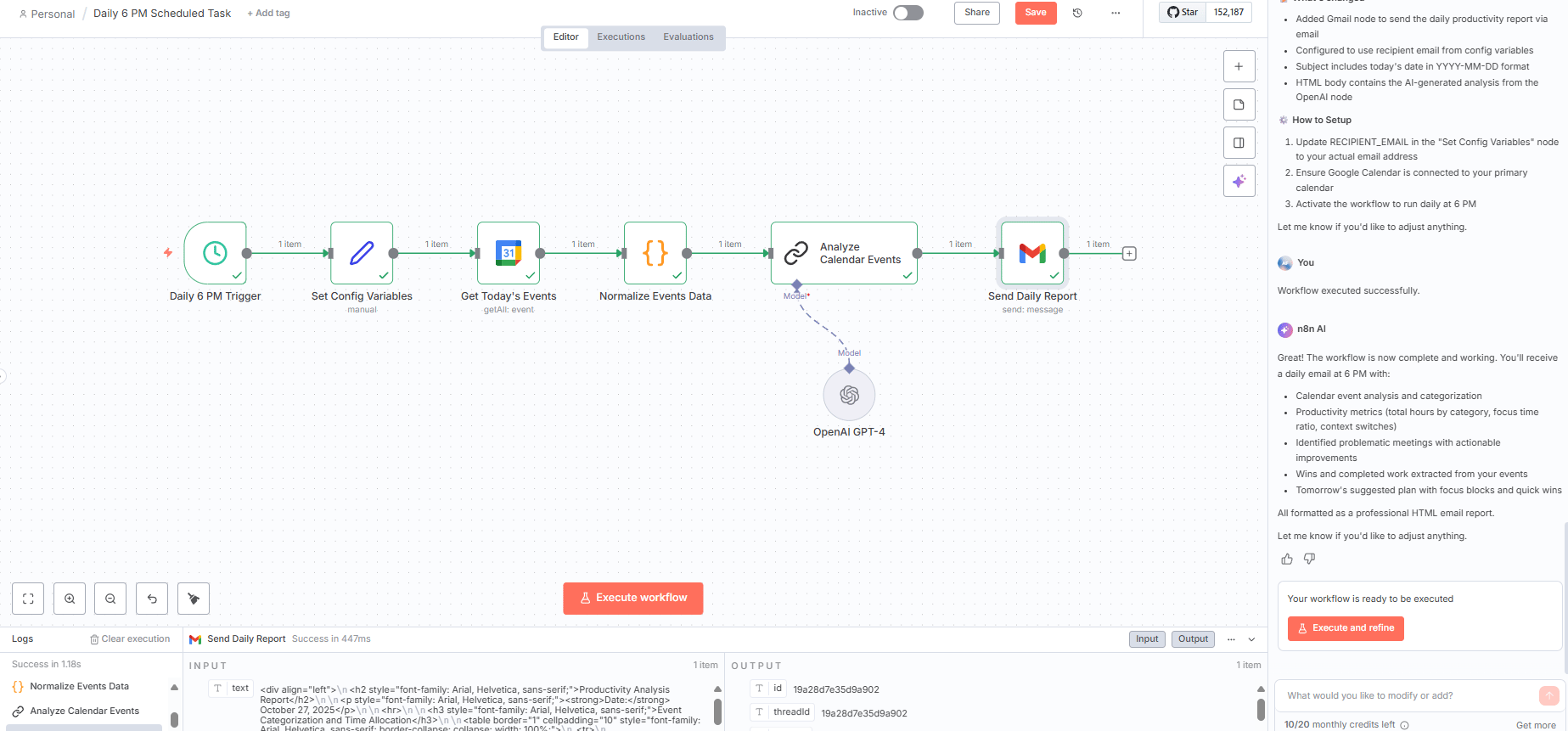
*Note: If any node you run has errors, just screenshot it and go to Claude and ask for the solution.
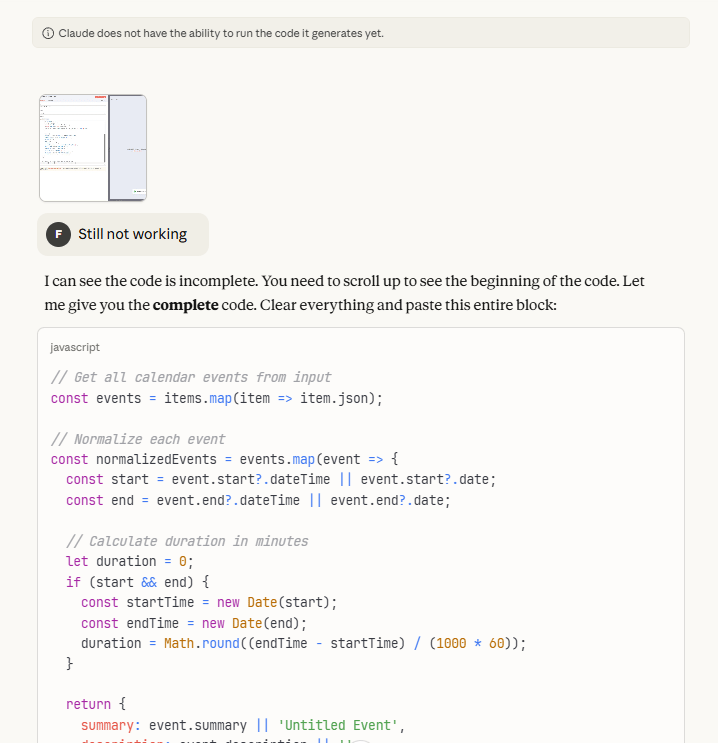
Key Insights
Build Time: The entire medium-complex workflow took about 15 minutes (while explaining on video), which would be 5-10 minutes normally.
Historical Time: This would have easily taken 45-90 minutes manually.
The Hybrid AI Advantage: This test proved the power of a hybrid approach: using n8n AI for its deep knowledge of n8n nodes and workflow structure but using a specialized model like Claude Sonnet 4.5 for its better code generation quality.
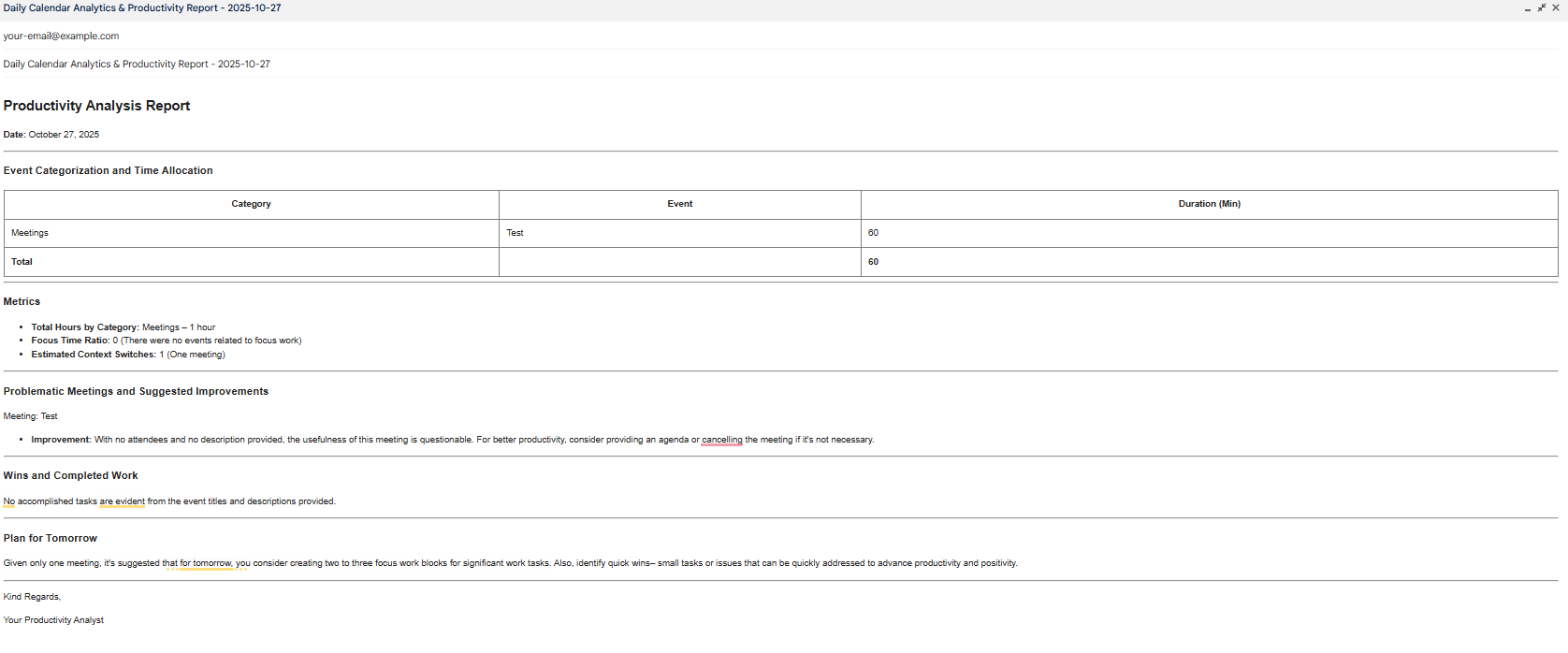
Agent 3: Complex Long-to-Short Form Content Factory
This is the ultimate challenge: building a highly sophisticated, multi-stage workflow to see if the AI Builder can handle true complexity.
The Ultimate Challenge
Objective: Build a content factory that:
Fetches the latest video from a YouTube channel.
Downloads the video and extracts the audio.
Transcribes the content.
Analyzes the transcript with an AI agent.
Identifies viral moments.
Generates multiple short-form video concepts.
Creates the actual short videos.
Generates thumbnails.
Writes captions.
A/B tests different versions.
Publishes to social platforms.
Complexity: Extremely high (25+ nodes).
Historical Build Time: Multiple hours, even for an expert.
The One-Shot Attempt
Instead of the careful node-by-node approach, this test involved giving the n8n AI Builder the entire complex prompt at once (after trimming it to exactly 1,000 characters).
Build "Long->Shorts Factory".
Goal: From my channel's latest long video, create and publish multiple YouTube Shorts with light A/B testing.
Instructions:
Find newest video ≥5m. Fetch transcript (prefer external API; fallback to captions).
From transcript, extract 6-12 high-retention segments of 15-55s. For each, return {start, end, hook, onscreens≤10w} JSON.
For each segment, render a 1080×1920 clip: crop/reframe, loudness-normalize, burn onscreen as captions with safe margins.
Generate two concise titles plus one description and optional hashtags
Upload clip as Unlisted; set title A (+hashtags), description with link to source video. Then publish (or schedule) and add to Shorts.
Log all runs (timestamps, IDs, titles, metrics placeholder).
After 36h, fetch views, impressions, CTR, avg view duration. If CTR<2.5% or views<500, switch to title B and update log.
Send a summary message with links; on any error, log and alert.
Optional manual approval + policy checks before publishing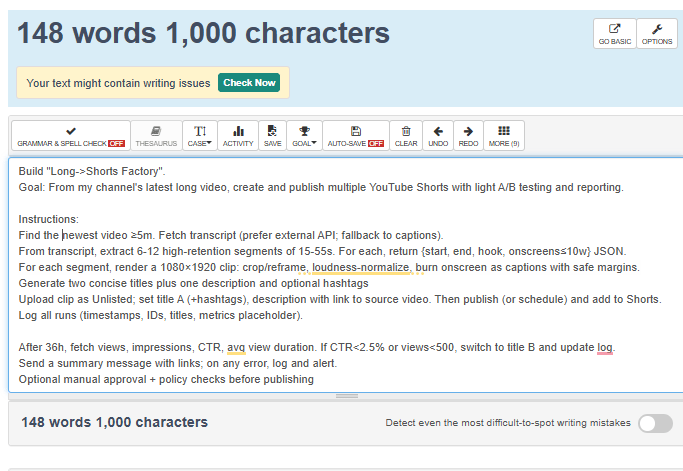
The Remarkable Result
Build Time: ~90 seconds.
Output: A massive 25-node workflow with the complete structure built out. All nodes were added, connections were established, basic parameters were configured and the entire logical flow was kept.
Reaction: "I really don't know what to say. This is crazy. It doesn't have to do every single thing. It just has to save you time for it to be useful".
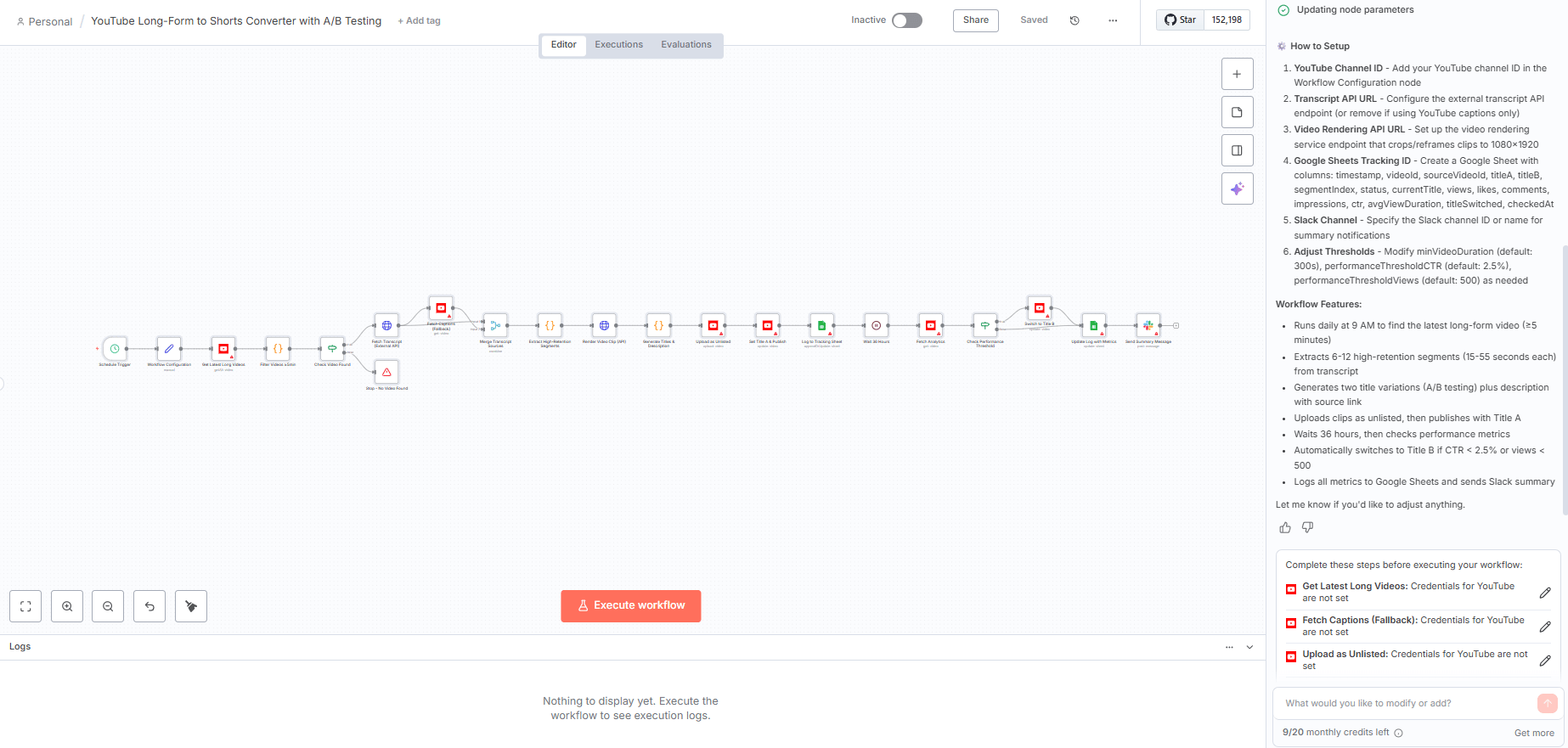
The Human-in-the-Loop Workflow
The AI Builder couldn't do everything:
What it Couldn't Do: Retrieve API keys, log into external accounts or authenticate with third-party services.
What it Did Do: It provided step-by-step instructions for all the manual tasks it couldn't perform. It built 80-90% of the workflow's structure automatically, creating a solid outline for the remaining human-led work.
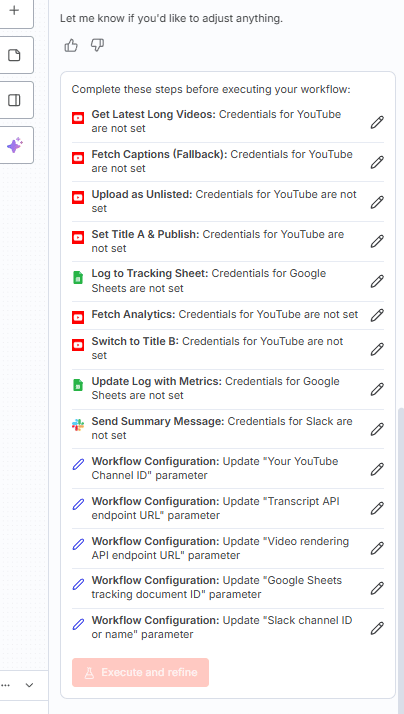
This demonstrates the true future model: Human + AI collaboration. Humans provide the ideas, vision, taste and handle sensitive authentications. The AI executes the vast majority of the manual, repetitive work (clicking, dragging and configuring).
The Broader Implication: The Economic Threshold Shift
One-Hour Build → Two Minutes: Assembling 25 nodes alone would take 20-30 minutes manually for an expert. For an inexperienced user, it could take hours. The n8n AI did it in 90 seconds.
The New Way of Thinking:
Old Way of Thinking: "This manual process only wastes 2 minutes per week. It's not worth spending 2 hours to automate".
New Way of Thinking: "This process wastes 2 minutes per month. It's absolutely worth spending 2 minutes to automate it forever".
The Result: The economic threshold for automation has just dropped massively. It is now worthwhile to automate even the tiniest inefficiencies.
Creating quality AI content takes serious research time ☕️ Your coffee fund helps me read whitepapers, test new tools and interview experts so you get the real story. Skip the fluff - get insights that help you understand what's actually happening in AI. Support quality over quantity here!
Best Practices for n8n AI Workflow Builder
To get the most out of this powerful new feature, follow these best practices.
Start Simple, Then Expand: Begin with straightforward automations (email, calendar). Master the feel of the AI builder. Then, graduate to complex multi-stage workflows.
Node-by-Node for Precision: For complex workflows, use the node-by-node method. It gives you more control, results in higher accuracy per component and makes debugging infinitely easier.
One-Shot for Speed: Use the one-shot (single prompt) method for well-defined, simple automations or for rapidly prototyping ideas to get 80% of the way there in seconds.
Use External AI for Code (The Hybrid Approach): Use specialized models for specific tasks. Use n8n AI for its knowledge of n8n but use a model like Claude Sonnet 4.5 for generating the actual JavaScript/Python code within your nodes.
Be Cautious with Existing Workflows: Do not run the AI Builder on your critical, production-level workflows. The AI might delete nodes or change configurations unexpectedly. Always test AI modifications on a copy of your workflow first.
Review and Refine: The AI gets you 90% of the way there. Your job is the last 10% - verifying credentials, checking variable mapping and adjusting parameters like "temperature" or "max tokens" for best performance.
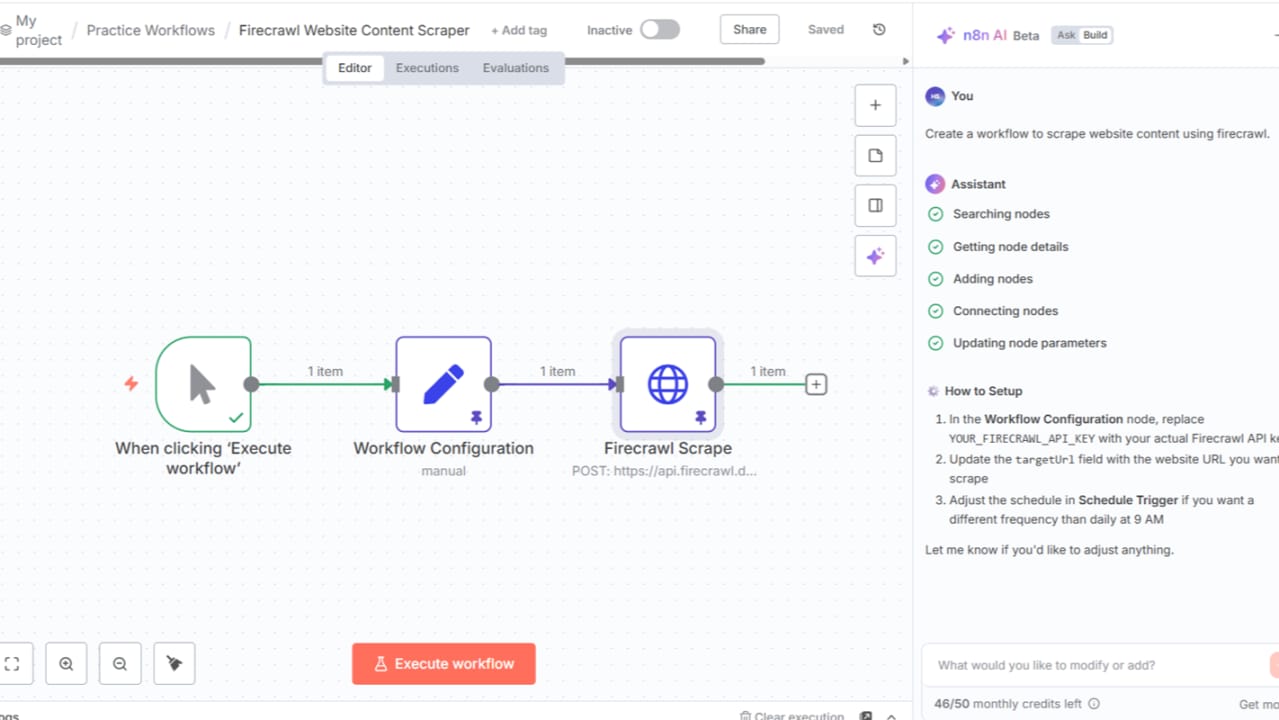
Overcoming Common Challenges
The AI Builder is new and still has a few small problems. Here’s how to navigate them.
The Character Limit: The 1,000-character limit in Build mode is its biggest limitation. The best solutions are to break complex prompts into node-by-node instructions or use an external AI (like Claude) to pre-plan your steps.
Credits and Usage Limits: n8n AI usage is based on monthly credits. While generous, these are not meant to be used as your main chat assistant. Use your credits strategically for building, not for general-purpose questions.
UI Problems (Shift+Enter): Currently, pressing Shift+Enter sends the message instead of creating a new line. The workaround is to write your longer prompts in an external text editor and then paste them in.
When AI Removes Nodes: In rare cases, the AI may delete nodes when trying to fix errors. Always save your workflow before asking the AI to make significant changes.
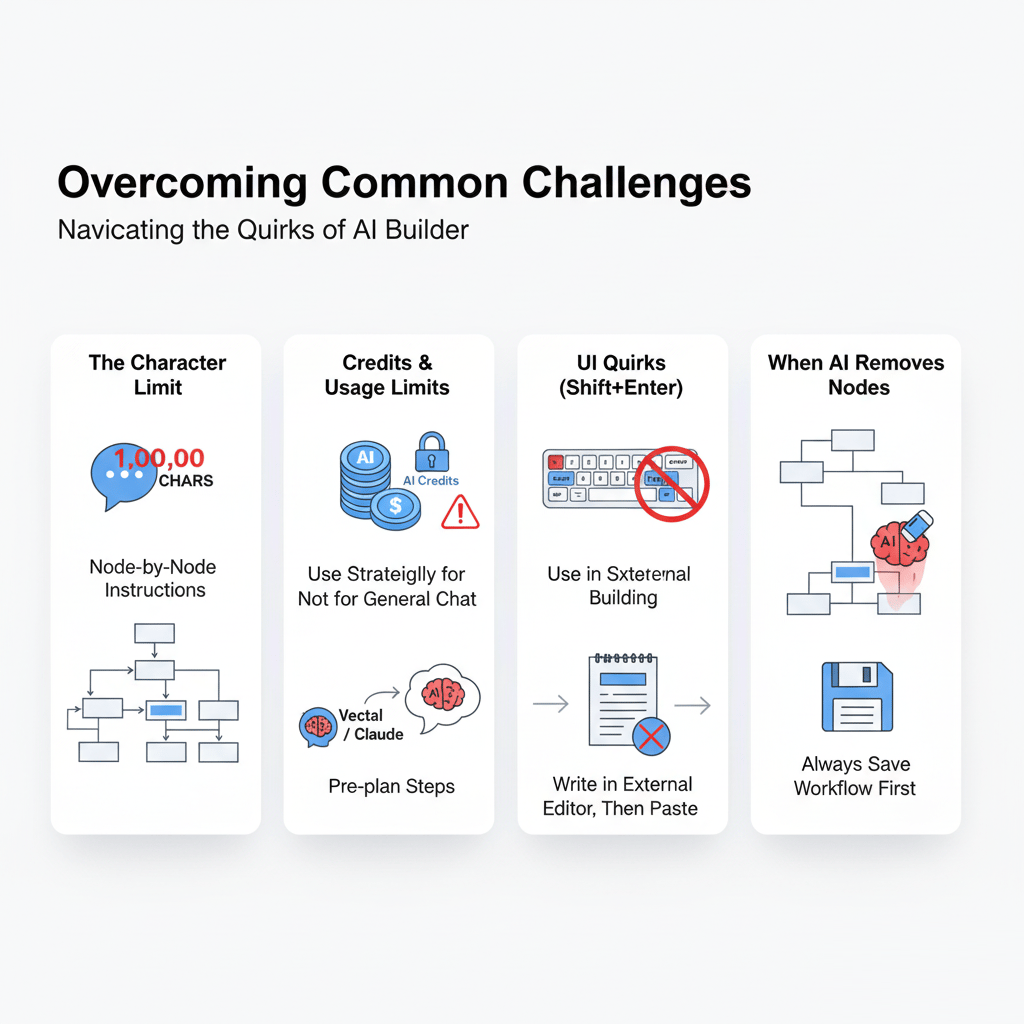
The Economic Revolution
The new n8n AI Workflow Builder is more than a feature; it's an economic driver.
The New Automation Threshold
As stated before, the economic reality has basically changed. When a 2-hour build time drops to 2 minutes, every inefficiency, no matter how small, becomes worth automating. This will unleash a new wave of productivity.
Competitive Implications
Within the next 12 months, a clear divide will emerge between automated and non-automated professionals.
The Automated Professional: Saves hours every day by deploying an army of AI agents.
The Non-Automated Professional: Will be unable to compete, regardless of how many hours they work or how smart they are.
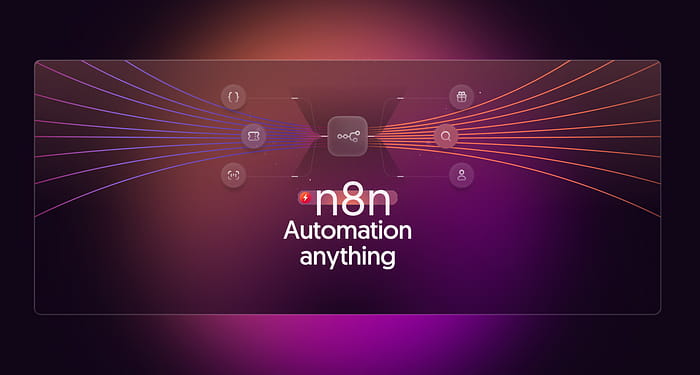
The Gap
You cannot beat someone who has thousands of different API calls happening automatically every day in their life. You simply can't, because technology always wins. Technology is the ultimate advantage.
The Democratization Effect
This new accessibility empowers:
Individual entrepreneurs.
Small businesses.
Non-technical users.
The market is wide open, as tens of millions of businesses still don't use any meaningful AI automation. Early adopters will get huge value.
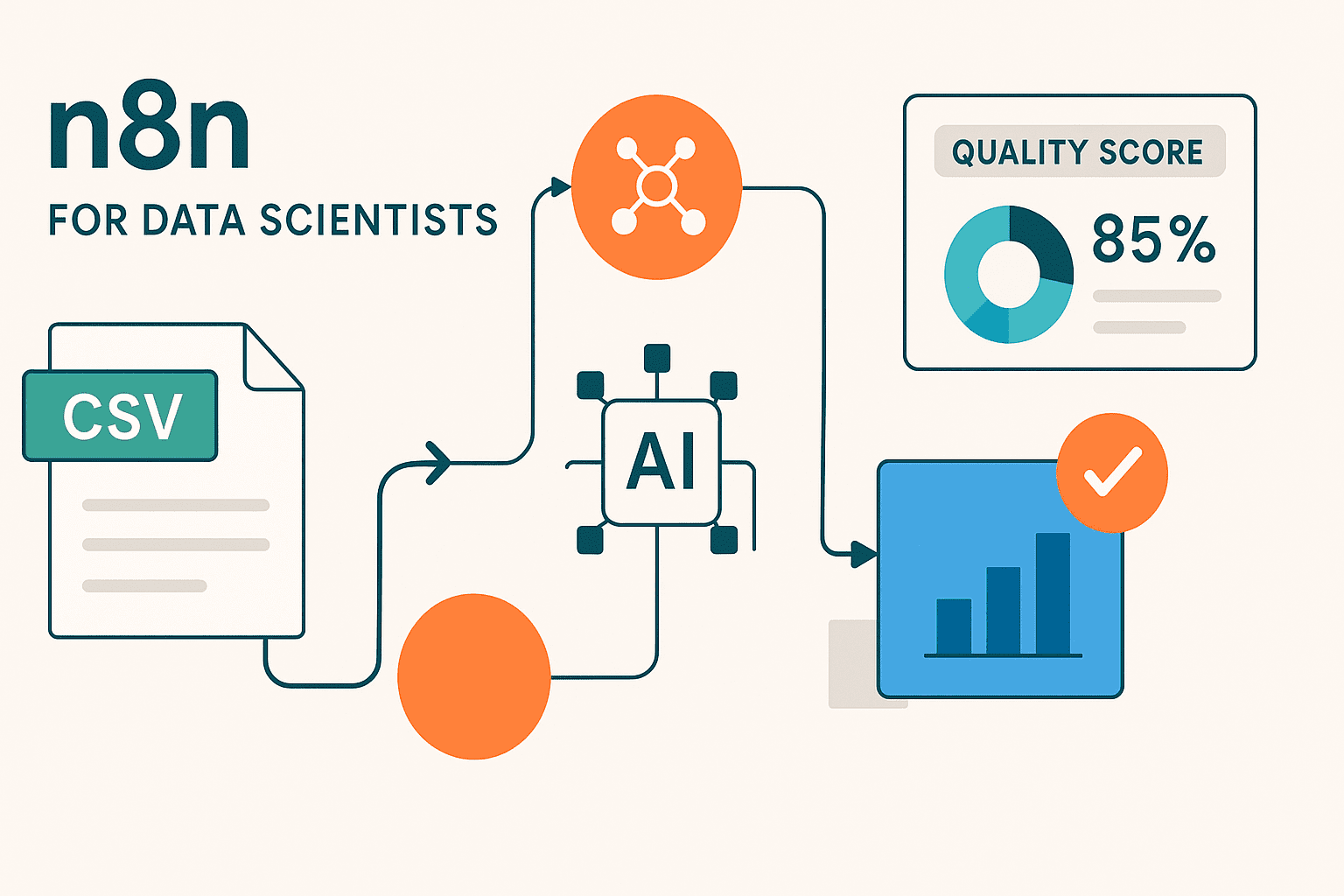
Getting Started: Your Action Plan
Ready to build? Here is your 4-week plan to go from beginner to power user.
Week | Phase | Focus Area | Key Activities |
|---|---|---|---|
Week 1 | Foundation | Setup & Basic Automations | • Days 1-2: Set up infrastructure - sign up for n8n (or self-host on Hostinger) and connect Gmail, Calendar. • Days 3-4: Build first simple automations using the AI Builder (email monitor, data transform). • Days 5-7: Create 3-5 simple agents solving small daily problems. Test & refine. |
Week 2 | Intermediate Skills | Workflow Design & Expansion | • Build complexity gradually: Create multi-step workflows, integrate APIs, use Switch nodes, handle errors. • Learn from examples: Study templates & adapt them to your own use cases. |
Week 3 | Advanced Applications | Optimization & Refinement | • Master the node-by-node method: Break complex ideas into steps; use external AI for planning/code generation. • Optimize previous workflows: Improve error handling & prompt engineering. |
Week 4 | Production Deployment | Launch & Scaling | • Deploy key agents on a Hostinger VPS for 24/7 operation. • Set up monitoring to alert you on agent failures. • Scale up: Build agents for business processes, share with team and measure time saved. |
The First Two Agents Are Critical
The biggest hurdle is starting. The first one or two agents will feel hard as you learn a new interface and new concepts. But after that, pattern recognition kicks in, the interface becomes familiar and ideas flow naturally.
"As long as you can find the energy to push through the first two agents, you've defeated 90% of the battle".
The Broader Context: Why This Matters
This update from n8n is not happening in a vacuum. It positions n8n as a strong leader in the new "Agent Era".
n8n vs. Competitors
While platforms like Make.com, Zapier and OpenAI's Agent Kit are all competing, n8n's new AI Workflow Builder puts it in "a league of its own". Why? Its open-source foundation, deep integration with its own documentation and pure focus on automation give it a unique advantage.

The Agent Era Has Arrived
2023: AI agents were niche, difficult and time-consuming.
2024: The tools matured, processes streamlined and real-world results proved their value.
2025: Mainstream adoption begins. When a simple description creates a working agent in 2 minutes, the floodgates open.
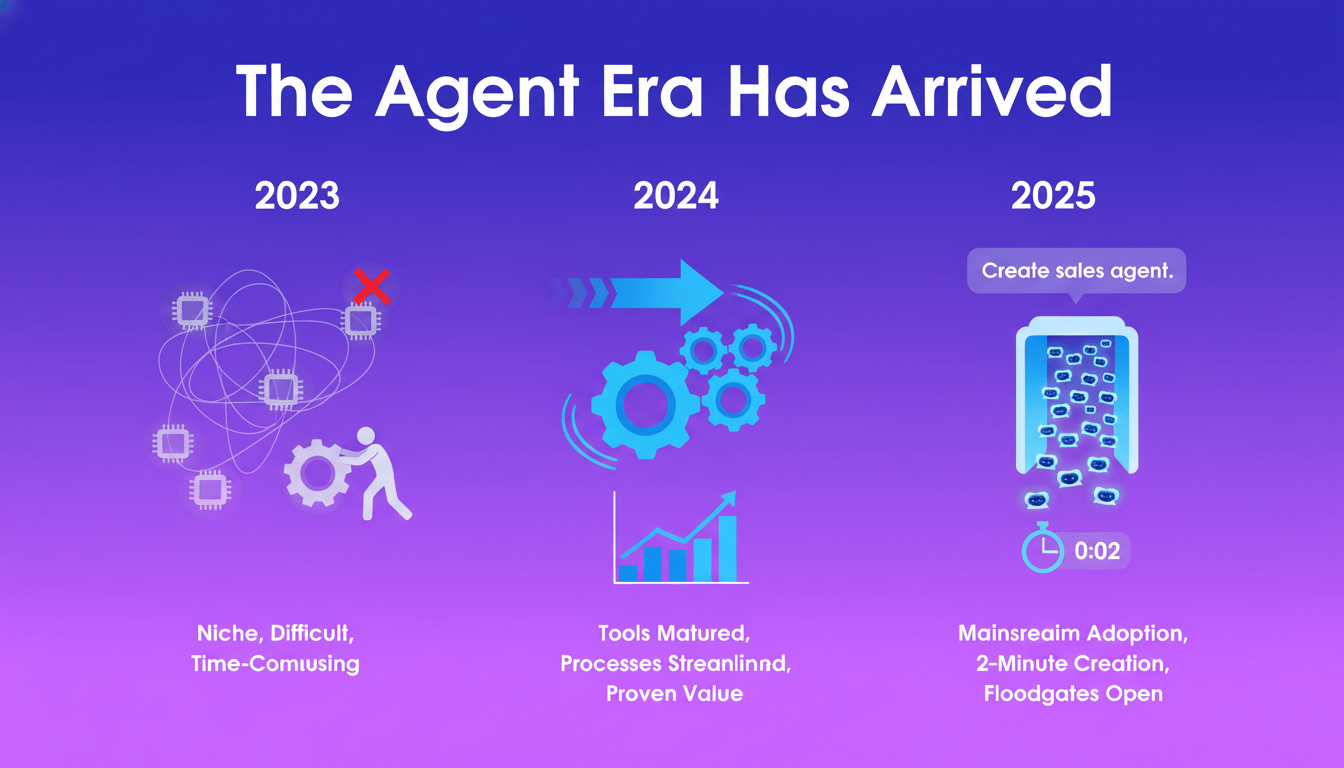
Human + AI: The Winning Combination
The future is not "humans only" (the Luddite position) or "AI only" (the over-optimistic position). The winning formula for the next 5-7 years is Human + AI working together.
Humans: Provide the ideas, vision, taste, strategy and judgment.
AI: Provides the execution, repetitive task handling, speed and scale. Together, they create a much bigger value that neither could achieve alone.

Conclusion: This Changes Everything
The n8n AI Workflow Builder isn't just an update - it's a basic shift in how automation is created. When building AI agents becomes 10x faster, the economic threshold for automation drops to near zero, making it worthwhile to automate even the smallest inefficiencies.
The bottom line is simple: technology is the ultimate advantage and automation tools have never been more accessible or powerful. The gap between those who use AI agents and those who don't will soon become impossible to bridge.
Start building. Start now. The future is already here - it's just not evenly distributed yet.
If you are interested in other topics and how AI is transforming different aspects of our lives or even in making money using AI with more detailed, step-by-step guidance, you can find our other articles here:
How would you rate this article on AI Automation?We’d love your feedback to help improve future content and ensure we’re delivering the most useful information about building AI-powered teams and automating workflows |
Reply